Jump Ahead To:
INFLATABLE KAYAK OUTRIGGER: INTRO
Kayak outriggers are one of our favorite pieces of kayak fishing gear. These handy after market products come in all different shapes and styles. Before we dive too deeply into the world of the inflatable kayak outrigger, we suggest that you take a quick look at our Kayak Outrigger Ultimate Guide, where we have posted an all encompassing and free resource containing everything you need to know about kayak outriggers. We have also ranked The 5 Best Kayak Outriggers!
Once you’ve developed your knowledge on the different types out outrigger, we suspect that you’ll be intrigued by the possibilities offered to you by an inflatable kayak outrigger, and this KFC post will walk you through some of their best features!
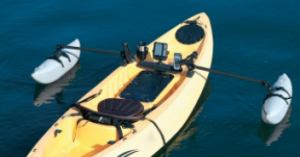
Inflatable Kayak Outrigger: Overview
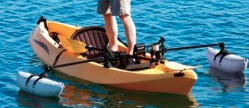
First, as an Amazon Associate, I earn from qualifying purchases.
This KFC post includes all of the important details about the inflatable kayak outrigger and why it might be a great addition to your collection of kayak fishing gear. To make an otherwise fairly complicated subject easy to follow, we have organized this post into a number of separate categories.
We start with a brief listing of inflatable kayak outrigger basics to help you build your knowledge of the subject. Next, we’ve written a short “how to” checklist aimed at helping you to get up and running with your inflatable kayak outrigger in no time flat! Next, we’ve listed a number of features of this particular product and show you why each particular feature is important to support your in your kayak fishing outings. Next, we have included a link to our favorite model of inflatable kayak outrigger and have included a brief story about our own experiences with this particular model.
Parts of a Kayak Outrigger
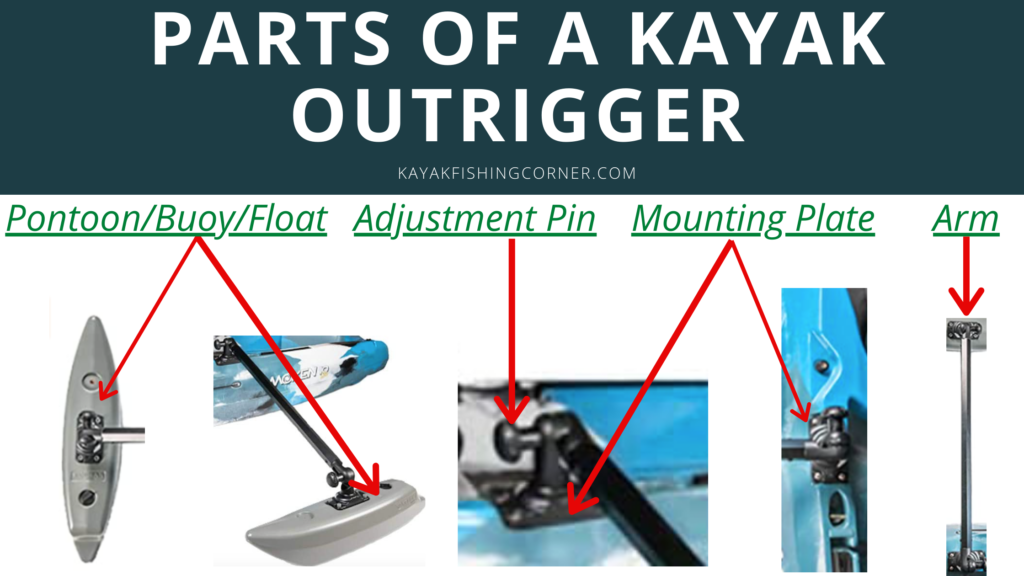
Inflatable Kayak Outrigger: Basics
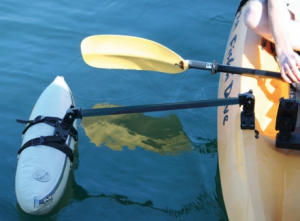
Please note: This post contains affiliate links. An affiliate link means that we may earn advertising/referral fees if you make a purchase through our links.
Shortcut to Inflatable Kayak Outrigger Review
A kayak outrigger, whether it is inflatable or hard sided, is essentially an extension of the width of the fishing kayak by way of the attachment of an aftermarket product. The kayak outrigger generally consists of three parts. First is a connection point to the hull of the fishing kayak itself. Second is the arm of the outrigger which spans the distance from the connection point to the buoy or pontoon connected to the end of the arm. Third is the previously mentioned buoy or pontoon, which is essentially a floatation device which is used to float atop the water and provide a buoyant base against which the kayak outrigger’s arm can push.
All inflatable kayak outrigger products will have a buoy or pontoon which is made of PVC coated outer shell materials protecting an inflatable inner air bladder. This is the key difference between a hard sided kayak outrigger for kayak fishing and the inflatable type model that we’ve written about in this post. The PVC coated shell is built with a zipper that is easy opened and closed to allow access to the air bladder. The air bladder can be inflated by pump or even by your lungs and, once inflated, provides a very buoyant float which is more than enough to keep the fishing kayak from overturning! If you do overturn, hopefully you are wearing a fishing kayak life jacket and you are able to remain calm while safely addressing the situation.
How to Use an Inflatable Kayak Outrigger
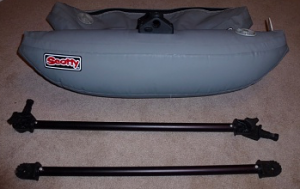
The whole purpose of an inflatable kayak outrigger is to elongate the width of the fishing kayak and create a more balanced and stable surface area from which the kayak fisherman can operate. The larger the width of the fishing kayak, the less likely the occurrence of an overturn! But what good is having an inflatable kayak outrigger if you don’t know how to properly install or use it. Well, take a look at the short checklist below. It will have you up and running in no time!
- First, decide where on the fishing kayak you want to install the outrigger.
- KFC always suggests that its readers locate the inflatable kayak outrigger near the stern (or rear) of the fishing kayak.
- Locating the outrigger towards the stern is ideal for keeping the outrigger arms out of the way of your paddling stroke.
- A rear location is also good for keeping your fishing line from becoming entangled with the outrigger’s arm or buoy.
- Next, install the connection point to the hull of the fishing kayak.
- Make sure that you install the connection point by using the mounting hardware that has come with your specific outrigger product.
- Once you’ve made a proper installation of the connection point to each side of the kayak’s hull (or one side, if you only want to install one arm of the kayak outrigger) you’ll want to connect the arms.
- Test the connection of the arms into the connection point. To do this, we like to pull the arms up and down and push them lightly side to side. Your outrigger arms should not twist within the connection point.
- Next, inflate the air bladder within the PVC coated outrigger buoy.
- Do this by using a common air pump, or even good old fashioned wind power from your lungs, and close the valve to enclose the air safely within the now full bladder.
- Zip up the protective PVC shell so that the air bladder remains protected from the elements and any rocks or sticks that you might run across while you are on the water.
- Now is the best time to connect the buoy to the arms of the outrigger.
- Confirm that you have made secure connection between the outrigger arm and the buoy. You’ll want to loop the included straps around the diameter of the buoy itself to add an extra layer of protection against one of the buoys getting loose and drifting away!
- That’s it! If you’ve followed the checklist above and any special instructions that have come with your inflatable kayak outrigger, you should be all set for a safe and fun kayak fishing outing!
Need more detail? Check out our post on how to use kayak outriggers and let us know if it does the trick!
Inflatable Kayak Outrigger: Important Features
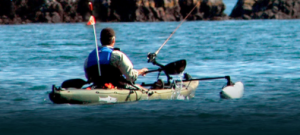
While each feature of an inflatable kayak outrigger is important insofar as every individual feature is critical for the inflatable kayak outrigger to function appropriately, there are a handful of main features that a deserve special attention. We go over the most critical features below. No matter which inflatable kayak outrigger you decide to move forward with, make sure that it contains these critical features below. Otherwise, its likely that you’ll be dissatisfied with your purchase.
Sturdy connection point. Having a high quality connection point is the first noteworthy key feature. This is the critical junction between the arm of the outrigger and the kayak’s hull. You’ll need to make certain that your connection point accomplishes two things.
First, you need to be sure that once you connect the arm of the outrigger to the connection point, that no unintentional separation of these two parts can occur. Ideally the connection points, or “mounts” as they are sometimes referred, are made of high quality material that can stand up to numerous instances of being wet, then dry, then wet again, without a weakening. If the material isn’t high quality, it will weaken over time and you will be at risk of a separation.
Second, you’ll want a failsafe type feature that assures you of a safe connection. Most high quality inflatable kayak outriggers come with “locking mounts” to ensure that the outrigger arm cannot slide free once the arm and mount become lubricated with water. A locking mount also provides the added convenience of being able to connect and disconnect the inflatable outrigger’s arms without any additional tools required. Oh, and speaking of connection points, if you’re looking for a good connection point for your fishing rod, perhaps a kayak rod holder would be a good fit for you.
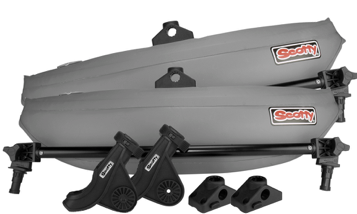
High Strength Arms. The arms of the inflatable kayak outrigger are going to face their fair share of strain as they bounce up and down along with the kayak in the water. Remember, the outrigger’s arms are essentially the bridge between the mounts and the pontoons. For that reason, they must be built of a material that allows them to be self supporting, containing the right amount of rigidity and flexibility that will allow them to perform in any number of water conditions.
You’ll want the arm of the inflatable kayak outrigger to reach at least 25 inches, and probably no longer than 36 inches. Any shorter than 25 inches and you will not have increased the width of the fishing kayak by a large enough amount to accomplish the increase in surface area needed to provide you the desired stability and control. Any longer than 36 inches and you’ll run the risk of the outrigger getting in the way of your attempt to navigate through tight channels.
Also, KFC has found that “anodized” arms, meaning arms that have been coated with a protective oxide layer (like aluminum), perform better in terms of longevity. Yes, high strength plastics typically perform very well, but for some reason the anodizing process seems to give the little bit of extra strength required to keep the inflatable kayak outrigger in good shape season after season. Oh, and the anodizing is also a nice touch in terms of performing in hot or cold temperatures, and keeping the product free from rust.

Quality Pontoons or Buoys. A high quality pontoon or buoy is absolutely critical. After all, the pontoon is going to be the piece of the inflatable kayak outrigger than bears the brunt of the pressure when the kayak is leaning far to one side or the other.
There are a number of low quality pontoons on the market. Trust us, the difference in price simply isn’t worth it. You want to move forward with a high quality pontoon that isn’t going to crack and rupture when exposed to cold temperatures or even glaring summer sunlight.
We’ve found that the best buoys are the ones that are actually two separate pieces – An inner air bladder, protected by an outer shell. The inner air bladder should be made of a durable plastic material, but its composition isn’t nearly as important as the outer shell. The outer shell is going to be the part of the inflatable kayak outrigger that is exposed to the water, temperature, and any obstacles that you might run across (like sticks and rocks) during a kayak fishing outing.
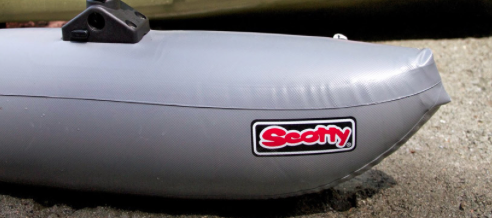
It is best to move forward with a PVC coated outer shell. PVC, or polyvinyl chloride, is one of the most widely used plastics in the world. It is used in a number of different aquatic industries, and its wide use is testament to its light weight, water proof, and highly durable chemical composition.
You still must be able to access the inside of the outer shell, of course, to access the air bladder. KFC suggests that you consider an inflatable outrigger with a zipper feature that allows you to open the outer shell by simply unzipping, access the bladder according to your needs, then simply zip back up to create a water tight seal!
The Best Inflatable Kayak Outrigger
(Commissions Earned)
The inflatable kayak outrigger showcased above has been one of our favorite pieces of kayak fishing gear in recent memory. The manufacturer has truly thought of, and included, everything with this out rigger kit.
Included are 2 inflatable buoys, 2 anodized outrigger arms measuring an appropriate 28 inches in length, 2 locking mounts, and even a couple of rod holders for good measure. The manufacturer claims that the inflatable buoys within the PVC coated outer shell offer over 30 pounds of additional buoyancy. This is ideal for those of us who like to stand while we are casting. No more risk of accidentally tipping over to one side!
The buoys are roughly 30″ long and 8″ wide, allowing access to a high quality interior air bladder via a zippered access point on each buoy. The manufacturer claims that you can disconnect, or reposition, the pontoons by merely pushing a button on the mount. We were skeptical, but it really is that easy. No special tools need to do so and, once connected, we felt that the risk of disconnect was very low indeed!
My Experience with an Inflatable Kayak Outrigger
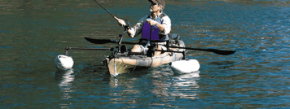
Kayak fishing involves a ton of different pieces of gear, not to mention the fishing kayak itself. The problem is, your space within the kayak, your vehicle, your garage, or your home, is limited. You’ve simply got to make space for all the gear or give it up.
We look for space saving kayak gear anywhere we can find it. With these inflatable kayak outrigger products, we are in luck. The pontoons are quickly and easily deflated, and the outrigger arms seamlessly disconnected, in a manner that allows you to store the inflatable kayak outrigger nearly anywhere. We love the convenience offered by the inflatable capabilities.
Also, at first we were concerned about the durability of the pontoons. After all, if they are inflatable, won’t they just “pop” if they run across a sharp object? We were mistaken. These pontoons are tough. The PVC coating makes these pontoons as durable as any hard-sided buoy in the kayak outrigger market today and best of all, when you are done, you simply deflate them, dry them off, and store them in a convenient area. No bulky pontoons sitting around the garage any longer!
INFLATABLE KAYAK OUTRIGGER: SCORES
Quality – 3.75/5
You can find inflatable kayak outriggers of all sorts of different levels of quality. Some are very, very cheaply made, so you’ll want to stay away from those. The model we’ve linked to above uses quality pontoons and solid arms, with each of these features going a long way in terms of making the product long lasting. That being said, we still have some concerns about the inflatable kayak outrigger’s ability to perform in moderately to highly choppy water conditions. Sometimes the waves can overwhelm the outrigger’s arms or even cause for the pontoons to become detached. The level of quality for this model is better suited for calmer water conditions.
Performance – 4.25/5
Inflatable outriggers are great tools in terms of having an immediate impact upon your abilities as a kayak fisherman. This inflatable outrigger is particularly great because you can inflate or deflate the pontoons to customize them in accordance with the water conditions you are facing. We frequently stand while casting and this outrigger keeps us perfectly upright and stable!
Price – 4/5
Inflatable outriggers will typically be more expensive than the non-inflatable models. You can usually find them for anywhere between $75 – $225. The range in price will depend upon whether you buy online or in a big box store. The price will also vary based upon whether your inflatable outriggers are part of a bigger package or not. Some come pre-packaged with other pieces of kayak fishing gear (like paddle leashes or rod holders). Sometimes this combination is a good value, other times it is not. Be sure to price the individual pieces of any package to determine whether you’d be better off buying them separately.
Durability – 3.75/5
The durability of the inflatable kayak outrigger is going to be directly tied to the type of water conditions that you expose it to. Obviously, the durability is going to be much better in smooth to moderately choppy water, with durability becoming compromised in very wavy conditions. If you will predominantly be kayak fishing in the ocean, we would suggest that you look towards some of the non-inflatable models of kayak outrigger. If, however, you will typically be on calmer waters and are just looking for a little extra stability when standing, this inflatable kayak outrigger linked to above would be of sufficient quality for you.
Overall – 3.9/5
Averaging 3.9 out of a possible 5 points, KFC would suggest that you look into buying an inflatable kayak outrigger for yourself, but only if you will be using it on light to moderately sized waves. The quality and durability are certainly adequate for calmer waters, but you’d be wise to consider a non-inflatable model for choppier conditions (especially for ocean waves). Whether you opt for the inflatable or non-inflatable model, an outrigger is a great piece of kayak fishing gear in terms of the immediate benefits that it brings to you, especially with regard to the additional peace of mind you’re provided while you’re on the water!
INFLATABLE KAYAK OUTRIGGER: CONCLUSION
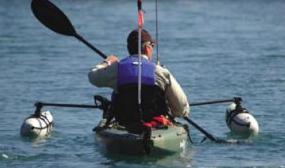
I hope this article has helped you learn more about all of the great benefits associated with the inflatable kayak outrigger type products on the market today! If you’ve read everything above and find that you still have questions about the inflatable kayak outrigger of whether it would be a good fit for you, make sure to comment on the bottom of this page. We’d love to be part of your decision making process! Learn more about inflatables, like the origin of the inflatable boat, here!
Ready to find a new favorite kayak fishing destination? Check out this list!
Comments
Do you own or have you ever used an inflatable kayak outrigger? Did you have a good experience? What overall score would you assign to it? Remember, if you have any questions about this article on the inflatable kayak outrigger, we’d love to discuss them with you! Please share your knowledge with the KFC Community by posting a comment below. I read and reply to all comments, and I love interacting with our readers!
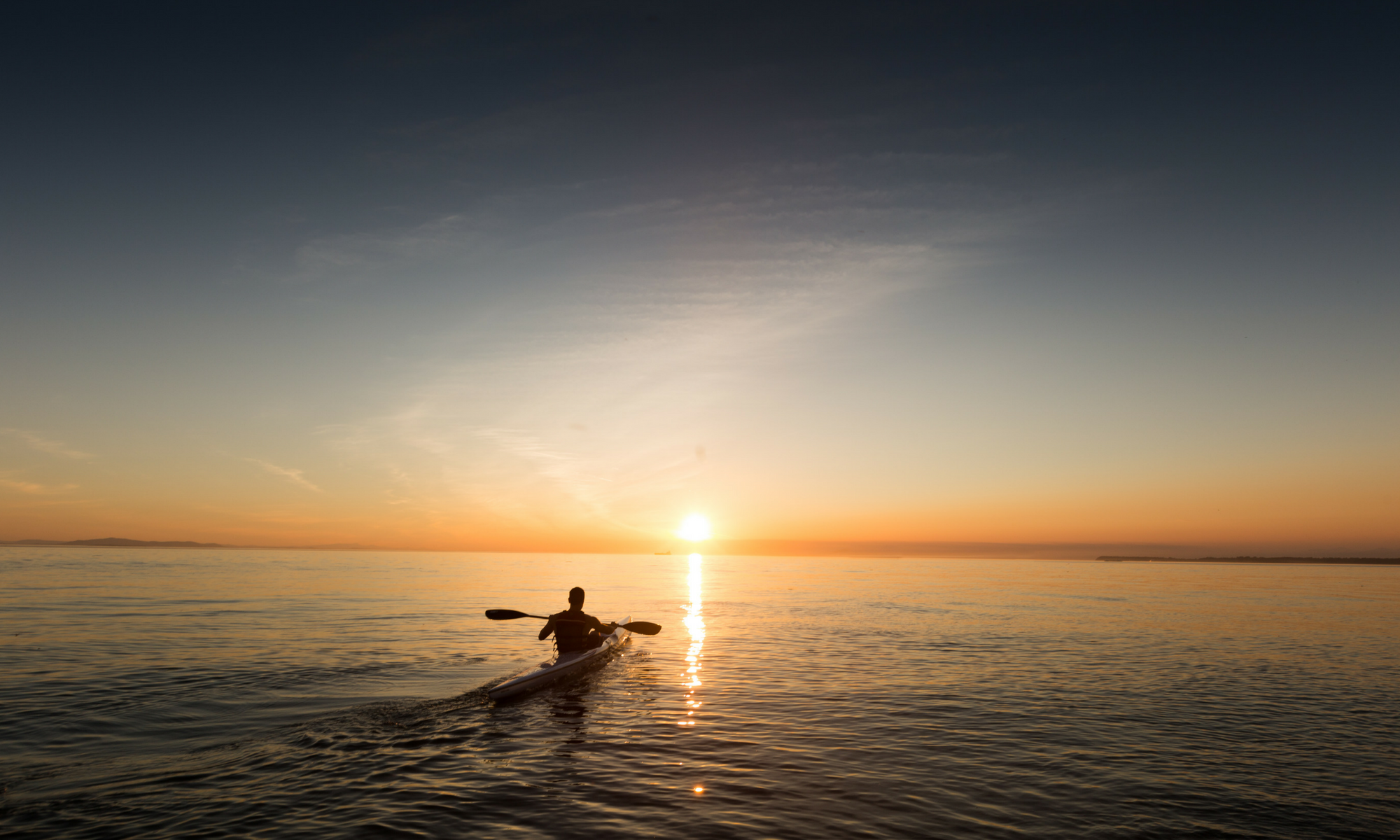
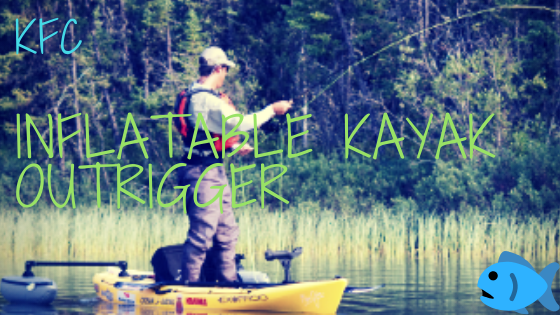

I’ve gained a few pounds ever since retiring from my job as a traveling account representative. Maybe it’s the location of my house right next to a Chipotel burrito shop! Will these outriggers keep a big ole boy upright and dry when I stand and cast? I’m not trying to go swimmin! I’ll keep that for the fish!
We’ll just attributable your weight gain to being more successful catching fish and bringing them home to the dinner table!
Yes, this outrigger will allow you to stand and cast with ease. The buoys are perfect for counterbalancing your weight, the waves and the kayak, all at the same time!
Are the buoys hard to inflate? How do they hold up during the Fall and Winter? That’s when I’m on the water the most!
Hi Jake,
They are easy to inflate. This isn’t like a stand up paddle board where you can pump for nearly a half hour before being done! Also, the buoys perform very well in hot and cold temperatures alike, just make sure to take them inside to a climate controlled area when you are not using them. This will enhance their durability!
– David Scott